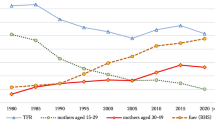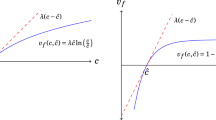Abstract
The present paper explores the impact of an intergenerational externality on private fertility decisions, under a pay-as-you-go social security system. The analysis is performed in the framework of a steady state growth model, with overlapping generations. To explain why households have children, altruism between parents and children is assumed. Surprisingly, the effects of altruism are not symmetric. The private fertility decisions are optimal only if children “love” their parents, because children then make private transfers at exactly the right level.
Similar content being viewed by others
References
Becker GS (1988) Family economics and macro behavior. Am Econ Rev 78:1–13
Bental B (1989) The old age security hypothesis and optimal population growth. J Popul Econ 1:285–301
Bernheim BD (1989) Intergenerational altruism, dynastic equilibria and social welfare. Rev Econ Stud 56:119–128
Cigno A (1983) On optimal family allowances. Oxford Econ Papers 35:13–22
Cigno A (1986) Fertility and the tax benefit system: A reconsideration of the theory of family taxation. Econ J 96:1035–1051
Deardorff AV (1976) The optimum growth rate for population: comment. Int Econ Rev 17:510–515
Diamond P (1965) National debt in a neoclassical growth model. Am Econ Rev 55:1126–1150
Klanberg F (1988) Konzepte eines optimalen Familienlastenausgleichs. In: Felderer B (ed) Familienla stenausgleich and demographische Entwicklung. Duncker & Humblot, Berlin, pp 29–52
Meltzer AH, Richard SF (1985) Debt and taxes with endogenous population, or why social security systems are prone to crises. Discussion Paper Carnegie-Mellon University, Pittsburgh, PA, June 1985
Nelissen HM, van den Akker AM (1988) Are demographic developments influenced by social security? J Econ Psychol 9:81–114
Nerlove M, Razin A, Sadka E (1987) Household and economy. Welfare economics of endogenous fertility. Academic Press, New York
Nugent JB (1985) The old-age security motive for fertility. Popul Dev Rep 11:75–97
Samuelson PA (1958) An exact consumption-loan model of interest with or without the social contrivance of money. J Polit Econ 66:467–482
Samuelson PA (1975) The optimum growth rate for population. Int Econ Rev 16:531–538
Schreiber W (1964) Kindergeld im sozio-ökonomischen Prozeβ. Sozialtheorie and Sozialpolitik 1. Kohlhammer, Köln Stuttgart
Swidler S (1986) The old-age security motive for having children and the effect of social security on completed family size. Qu Rev Econ Business 26:14–34
Willis RJ (1987) What have we learned from the economics of the family? Am Econ Rev 77:68–81
Author information
Authors and Affiliations
Additional information
Comments of participants of a seminar on economic theory of Prof. K. Jaeger at Free University of Berlin at July 20, 1989, are gratefully acknowledged. I am indebted to Alessandro Cigno, Frank Klanberg and Elmar Wolfstetter for many helpful suggestions.
Rights and permissions
About this article
Cite this article
Prinz, A. Endogenous fertility, altruistic behavior across generations, and social security systems. J Popul Econ 3, 179–192 (1990). https://doi.org/10.1007/BF00163074
Received:
Accepted:
Issue Date:
DOI: https://doi.org/10.1007/BF00163074




